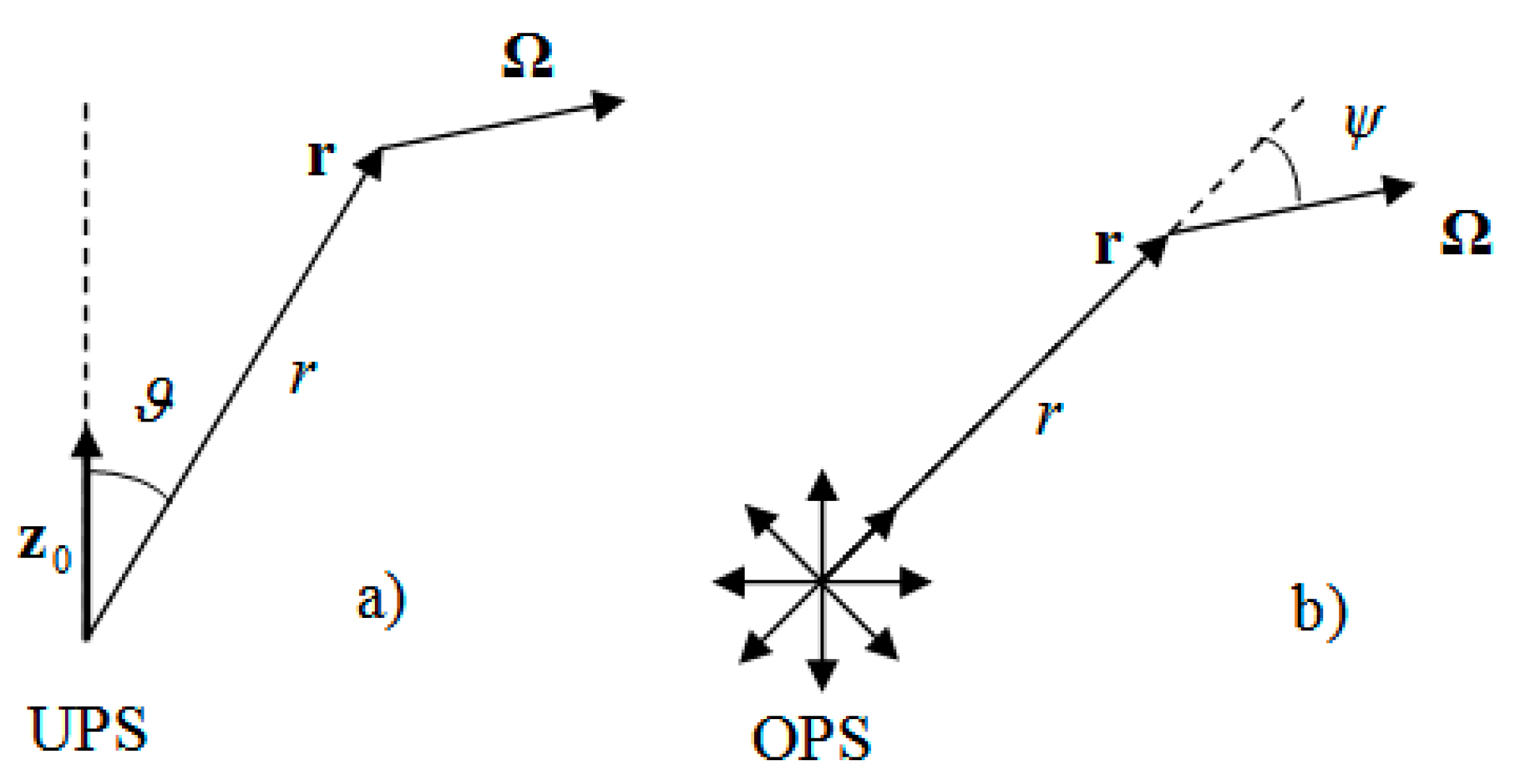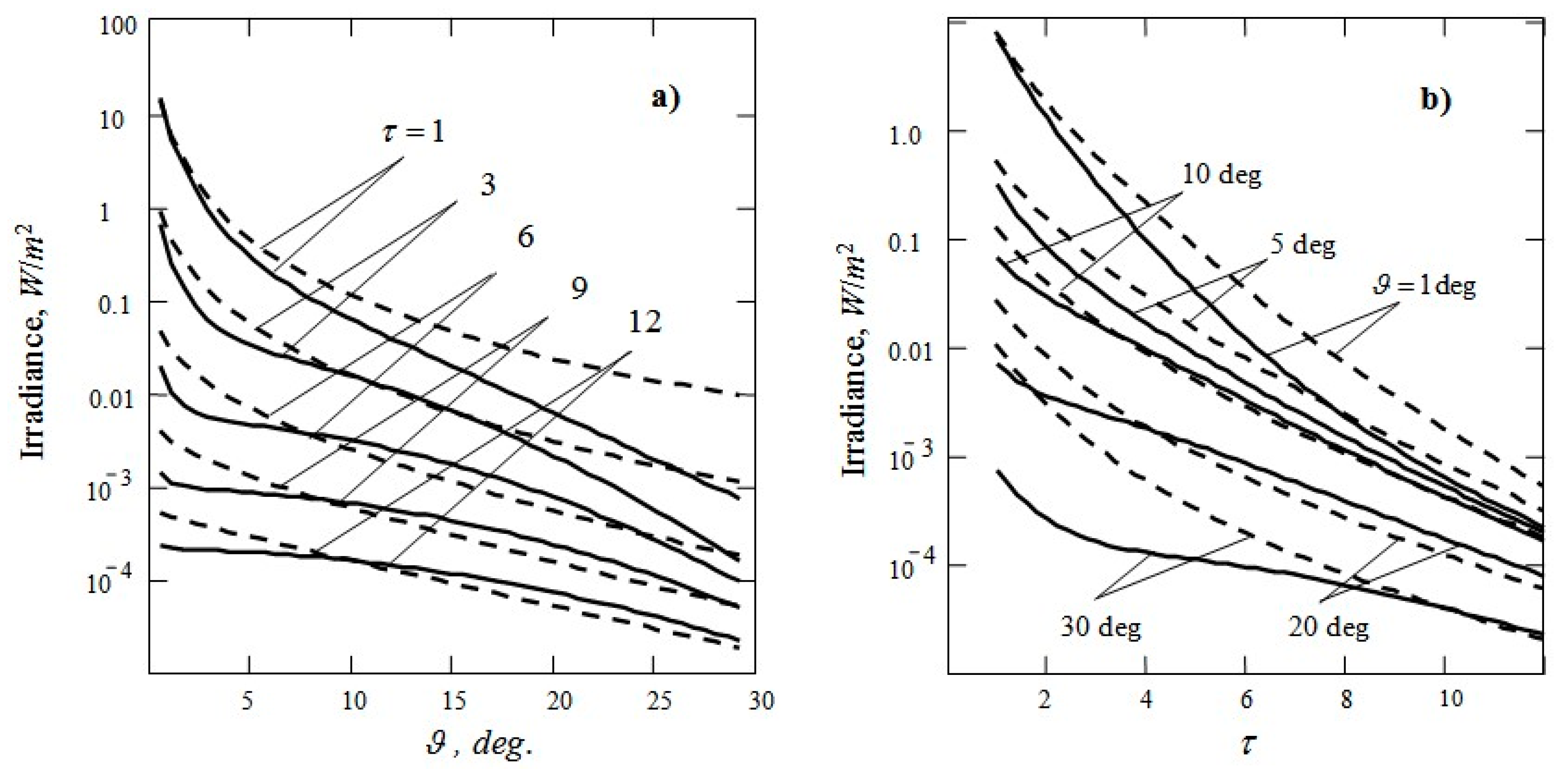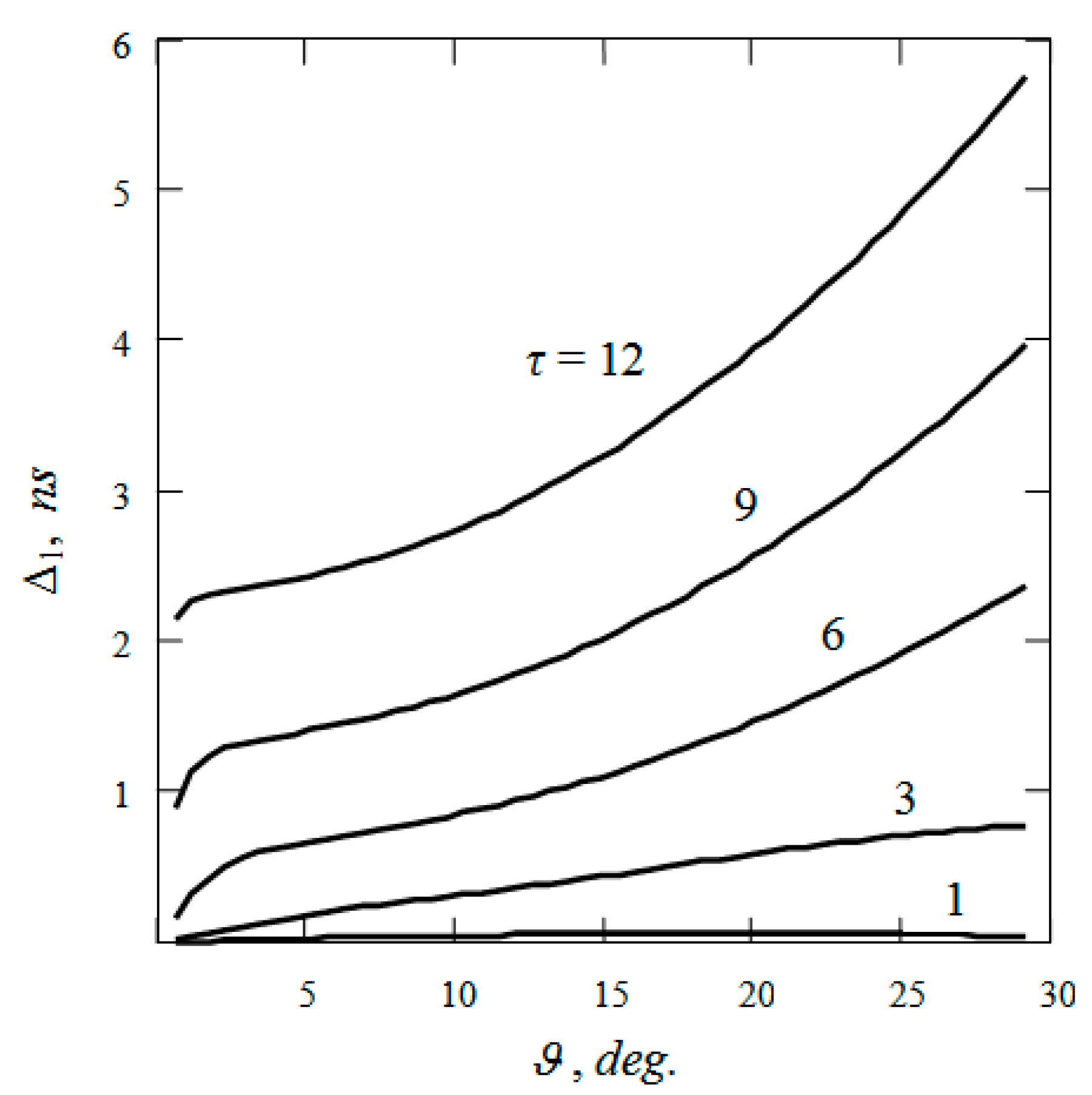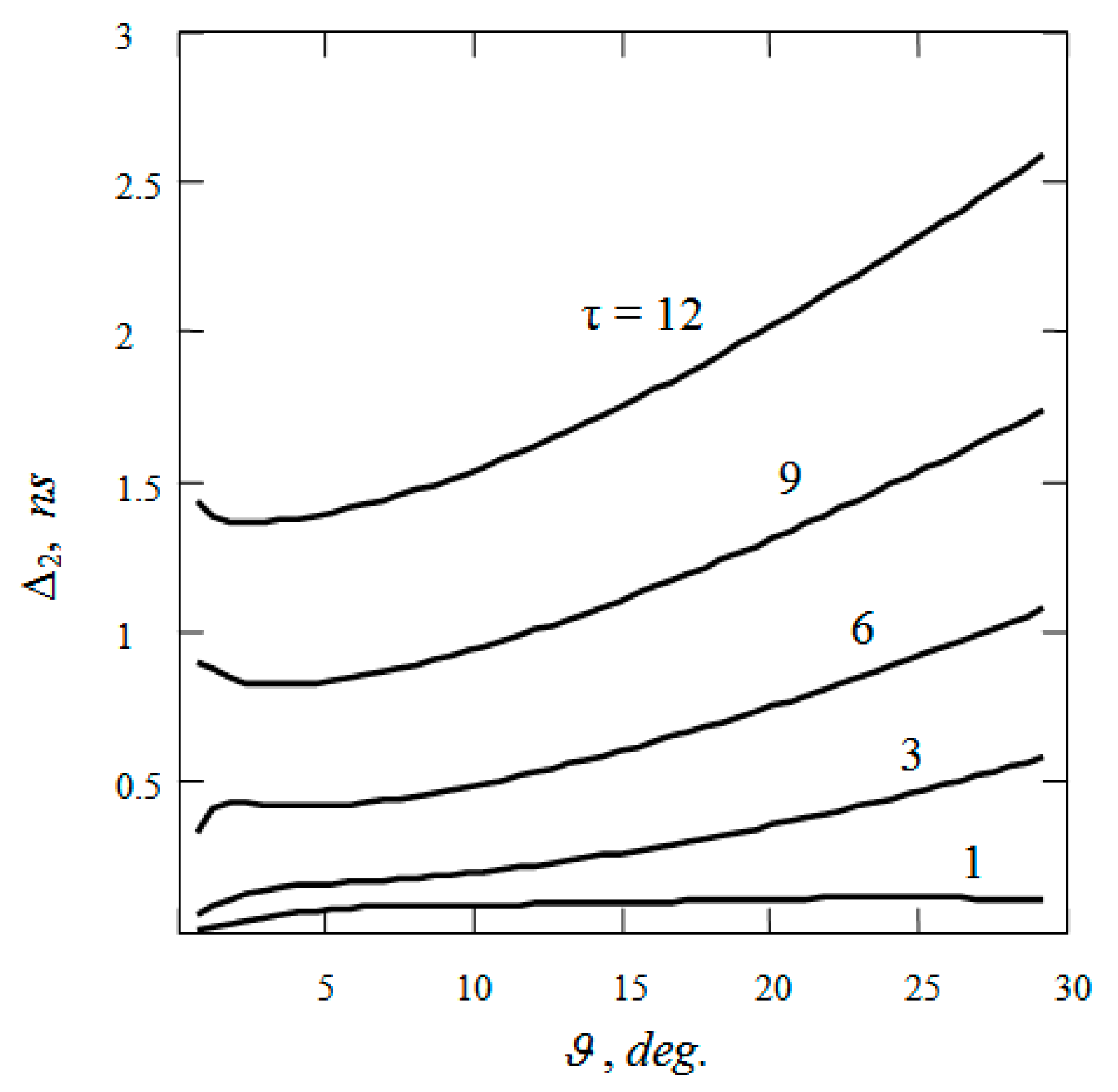New Theoretical Model of the Irradiance Distribution in Water from a Unidirectional Point Source
Abstract
1. Introduction
2. Statement of the Problem and Initial Equations
3. Model of the OPS Light Field
3.1. Formulas for Calculating the Radiances of Single and Double Scattered Light
3.2. Equation for the Radiance of Multiple Scattered Light
3.3. Formulas for Calculating the Radiance of Multiple Scattered Light
4. Simulation of the Structure of a Narrow Light Beam in Water
5. Conclusions
Funding
Acknowledgments
Conflicts of Interest
References
- Jaffe, J.S.; Moore, K.D.; McLean, J.; Strand, M.P. Underwater optical imaging: Status and prospects. Oceanography 2001, 14, 64–75. [Google Scholar] [CrossRef]
- Levin, I.M. Observation of objects illuminated by a narrow light beam in a scattering medium. Izvestiya Acad. Sci. USSR Atmos. Ocean. Phys. 1969, 5, 62–76. [Google Scholar]
- Bravo-Zhivotovsky, D.M.; Dolin, L.S.; Luchinin, A.G.; Savel’ev, V.A. Some problems of the theory of visibility in turbid media. Izvestiya Acad. Sci. USSR Atmos. Ocean. Phys. 1969, 5, 388–393. [Google Scholar]
- Mertens, L.E.; Replogle, F.S. Use of point spread and beam spread function for analysis of imaging systems in water. J. Opt. Soc. Am. 1977, 67, 1105–1117. [Google Scholar] [CrossRef]
- Dolin, L.S.; Levin, I.M. Theory of Underwater Vision; Hydrometeoizdat: Leningrad, Russia, 1991; p. 230. [Google Scholar]
- Zege, E.P.; Ivanov, A.P.; Katsev, I.L. Image Transfer through a Scattering Medium; Springer: Berlin/Heidelberg, Germany, 1991; p. 349. [Google Scholar]
- Luchinin, A.G.; Dolin, L.S. Model of an underwater imaging system with a complexly modulated illumination beam. Izvestiya Atmos. Ocean. Phys. 2014, 50, 411–419. [Google Scholar] [CrossRef]
- Dolin, L.S.; Savel’ev, V.A. Characteristics of back scattering signal at pulse radiation of turbid medium by a narrow directional light beam. Izvestiya Acad. Sci. USSR Atmos. Ocean. Phys. 1971, 7, 505–510. [Google Scholar]
- Billard, B.; Abbot, R.H.; Penny, M.F. Airborne estimation of sea turbidity parameters from the WRELADS laser airborne depth sounder. Appl. Opt. 1986, 25, 2080–2088. [Google Scholar] [CrossRef]
- Hoge, F.E.; Wright, C.W.; Krabill, W.B.; Buntzen, R.R.; Gilbert, G.D.; Swift, R.N.; Yungel, J.K.; Berry, R.E. Airborne lidar detection of subsurface oceanic scattering layers. Appl. Opt. 1988, 27, 3969–3977. [Google Scholar] [CrossRef]
- Measures, R.M. Laser Remote Sensing: Fundamentals and Applications; Krieger: Malabar, FL, USA, 1992; p. 524. [Google Scholar]
- Walker, R.E. Marine Light Statistics; Wiley: New York, NY, USA, 1994; p. 675. [Google Scholar]
- Bunkin, A.F.; Vlasov, D.V.; Mirkamilov, D.M.; SLOBODIANIN, V. Laser airborne remote sensing of turbidity profiles and mapping of phytoplankton distribution. Akademiya Nauk SSSR Doklady 1984, 277, 335–337. [Google Scholar]
- Vasilkov, A.P.; Goldin, Y.A.; Gureev, B.A.; Hoge, F.E.; Swift, R.N.; Wright, C.W. Airborne polarized lidar detection of scattering layers in the ocean. Appl. Opt. 2001, 40, 4353–4364. [Google Scholar] [CrossRef]
- Feygels, V.I.; Kopilevich, Y.I.; Surkov, A.I.; Yungel, J.K.; Behrenfeld, M.J. Airborne lidar system with variable field-of-view receiver for water optical measurements. Proc. SPIE 2003, 5155, 12–21. [Google Scholar]
- Churnside, J.H.; Ostrovsky, L.A. Lidar observation of a strongly nonlinear internal wave train in the Gulf of Alaska. Int. J. Remote Sens. 2005, 26, 167–177. [Google Scholar] [CrossRef]
- Kopilevich, Y.I.; Feygels, V.I.; Tuell, G.H.; Surkov, A. Measurement of ocean water optical properties and seafloor reflectance with scanning hydrographic operational airborne lidar survey (SHOALS): I. Theoretical background. Proc. SPIE 2005, 5885, 106–114. [Google Scholar]
- Tuell, G.H.; Feygels, V.; Kopilevich, Y.; Weidemann, A.D.; Cunningham, A.G.; Mani, R.; Podoba, V.; Ramnath, V.; Park, J.Y.; Aitken, J. Measurement of ocean water optical properties and seafloor reflectance with scanning hydrographic operational airborne lidar survey (SHOALS): II. Practical results and comparison with independent data. Proc. SPIE 2005, 5885, 115–127. [Google Scholar]
- Luchinin, A.G. Theory of underwater lidar with a complex modulated illumination beam, Izvestiya. Atmos. Ocean. Phys. 2012, 48, 663–671. [Google Scholar] [CrossRef]
- Dolin, L.S. Light beam scattering in a turbid medium layer. Izvestiya Vysshikh Uchebnykh Zavedenii, Radiofizika. 1964, 7, 471–478. [Google Scholar]
- Dolin, L.S. Propagation of a narrow beam of light in a medium with strongly anisotropic scattering. Izvestiya Vysshikh Uchebnykh Zavedenii, Radiofizika. 1966, 9, 40–47. [Google Scholar] [CrossRef]
- Bravo-Zhivotovsky, D.M.; Dolin, L.S.; Luchinin, A.G.; Savel’ev, V.A. Structure of a narrow light beam in sea water. Izvestiya Acad. Sci. USSR Atmos. Oceanic Phys. 1969, 5, 160–167. [Google Scholar]
- Arnush, D. Underwater light-beam propagation in the small-angle approximation. J. Opt. Soc. Am. 1972, 62, 1109–1111. [Google Scholar] [CrossRef]
- Ishimaru, A. Wave Propagation and Scattering in Random Media; Academic Press: New York, NY, USA, 1978; p. 272. [Google Scholar]
- Dolin, L.S.; Savel’ev, V.A. Theory of the propagation of a narrow light beam in a stratified scattering medium. Izvestiya Vysshikh Uchebnykh Zavedenii, Radiofizika. 1979, 22, 911–917. [Google Scholar] [CrossRef]
- Furutsu, K. An analytical theory of pulse wave propagation in turbulent media. J. Math. Phys. 1979, 20, 617–628. [Google Scholar] [CrossRef]
- Ishimaru, A. Pulse propagation, scattering, and diffusion in scatterers and turbulence. Radio Sci. 1979, 14, 269–276. [Google Scholar] [CrossRef]
- Dolin, L.S. Solution of the radiation transfer equation in a small-angle approximation for a stratified turbid medium with photon path dispersion taken into account. Izvestiya Acad. Sci. USSR Atmos. Ocean. Phys. 1980, 16, 55–64. [Google Scholar]
- Hulst, H.C.; Kattawar, G. Exact spread function for pulsed collimated beam in a medium with small-angle scattering. Appl. Opt. 1994, 33, 5820–5829. [Google Scholar] [CrossRef]
- Luchinin, A.G.; Savel’ev, V.A. Propagation of a sinusoidally modulated light beam through a scattering medium. Izvestiya Vysshikh Uchebnykh Zavedenii, Radiofizika. 1969, 12, 256–264. [Google Scholar] [CrossRef]
- Rogozkin, D.B. Propagation of light pulse in a medium with strongly anisotropic scattering. Izvestiya Acad. Sci. USSR Atmos. Ocean. Phys. 1987, 23, 275–281. [Google Scholar]
- Dolin, L.S. Self-similar approximation in the theory of the strongly anisotropic multiple scattering of light. Doklady 1981, 1344–1347. [Google Scholar]
- Dolin, L.S. Passage of a pulsed light signal through an absorbing medium with strongly anisotropic scattering. Izvestiya Vysshikh Uchebnykh Zavedenii, Radiofizika. 1983, 26, 220–228. [Google Scholar] [CrossRef]
- McLean, J.W.; Freeman, J.D.; Walker, R.E. Beam spread function with time dispersion. Appl. Opt. 1998, 37, 4701–4711. [Google Scholar] [CrossRef]
- Case, K.M.; Zweifel, P.F. Linear Transport Theory; Addison-Wesley: London, UK, 1967; p. 342. [Google Scholar]
- Sergeeva, E.A.; Kirillin, M.Y.; Priezzhaev, A.V. Propagation of a femtosecond pulse in a scattering medium: Theoretical analysis and numerical simulation. Quantum Electron. 2006, 36, 1023–1031. [Google Scholar] [CrossRef]
- Zege, E.P.; Katsev, I.L.; Prikhach, A.S.; Gilbert, G.; Witherspoon, N. Simple model of the optical characteristics of bubbles and sediments in seawater of the surf zone. Appl. Opt. 2006, 45, 6577–6585. [Google Scholar] [CrossRef] [PubMed]
- Levin, I.M.; Kopelevich, O.V. Correlations between the inherent hydrooptical characteristics in the spectral range close to 550 nm. Oceanology 2007, 47, 344–349. [Google Scholar] [CrossRef]
- Dolin, L.S.; Savel’ev, V.A. New model for the light-beam spread function in a medium with strongly anistropic scattering. Izvestiya Atmos. Ocean. Phys. 2000, 36, 730–736. [Google Scholar]




© 2020 by the author. Licensee MDPI, Basel, Switzerland. This article is an open access article distributed under the terms and conditions of the Creative Commons Attribution (CC BY) license (http://creativecommons.org/licenses/by/4.0/).
Share and Cite
Dolin, L.S. New Theoretical Model of the Irradiance Distribution in Water from a Unidirectional Point Source. J. Mar. Sci. Eng. 2020, 8, 79. https://doi.org/10.3390/jmse8020079
Dolin LS. New Theoretical Model of the Irradiance Distribution in Water from a Unidirectional Point Source. Journal of Marine Science and Engineering. 2020; 8(2):79. https://doi.org/10.3390/jmse8020079
Chicago/Turabian StyleDolin, Lev S. 2020. "New Theoretical Model of the Irradiance Distribution in Water from a Unidirectional Point Source" Journal of Marine Science and Engineering 8, no. 2: 79. https://doi.org/10.3390/jmse8020079
APA StyleDolin, L. S. (2020). New Theoretical Model of the Irradiance Distribution in Water from a Unidirectional Point Source. Journal of Marine Science and Engineering, 8(2), 79. https://doi.org/10.3390/jmse8020079



